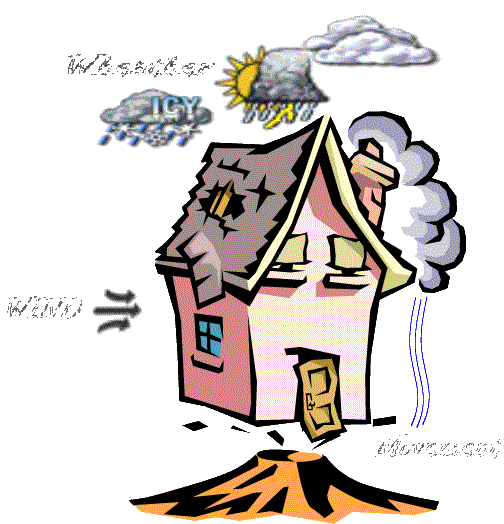 This
area is the most important element of a home next to the site itself.
This
area is the most important element of a home next to the site itself.
For this reason I will explain the foundation in two parts - the dynamics or physics [simplified] involved in the construction and the three basic construction methods.
But first, lets review a couple of things.
Remember in the site page we discussed the various textures of the earth and how they react to gravity, movement and moisture? Now we must consider the construction of the foundation to overcome or work properly with the type of site surface we wish to build upon.
The
foundation is the homes component that we (engineers) use to control the
various forces we discussed on the site page.
There are four primary forces that work on destroying your home.
-
Weight (gravity reaction)
-
Movement (from all internal and external sources)
-
Internal Stresses (including thermodynamics - you've heard the expression that a house breaths or expand and contract)
-
Wind and Water (which are influencing factors of the other three forces)
Think of the foundation as the frame of a truck. Above the frame is the passenger compartment (house) and below the frame is the road (site), which requires the proper wheels, chassis and drive train (substructure of the foundation) to be able to operate, and just as you wouldn't consider "off-roading" in the family minivan, the foundation construction must match the soil type and home construction.
Foundations are designed with the house in mind and what the foundation must control given the size of house above the foundation, is critical. Lets think of it this way. Would you expect to be able to unload a semi truck into the trunk of a beetle?
Weight and movement exert two types of loads.
-
Dead weight or static loads (loads that don't continuously change and are elements of gravity)
-
Live weight and/or movement or dynamic loads (the opposite of static loads and continuously change like people walking from room to room, furniture or even rain or snow on the roof)
The static load is from gravity and remains constant on the foundation while the dynamic load is from movement within the structure.
Internal stresses are exerted in four types of dynamic forces.
-
Compression which is the stress exerted to make things smaller
-
Tension which is the stress exerted to pull things apart
-
Shear which is the stress being applied in two opposite directions
-
Bending stress which is the stress being applied to move building components in one direction.
Thermodynamics, which is the expansion and contraction of the buildings components as temperatures rise and fall inside the house versus outside the house, influence the internal stresses in the house. In the morning sun, the east side of the house warms up (expands) as the west side remains cold and visa versa in the evening.
Additionally, at any single moment in time, any combination of dynamic forces can be working on your home.
(FYI - Did you know that a two story home's roof can move over an inch during the course of a day. That's why sometimes when you think you have ghosts as you see doors closing by their self in the mid-day sun, it's just that the house is now leaning more to one side causing the door to close.)
The last two elements are given to us directly by mother nature.
-
Winds which push on the house
-
Water which adds weight if applied to the surface (roof for example) or used to create movement if in the ground pushing on various sections of the foundation.
These are the forces that the architect and structural engineer must consider when designing your home.
Now lets go to the actual building of the foundation and its components...